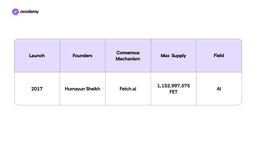Understanding Fetch.ai (FET): a complete guide with essential information
December 20, 2023
5 min

What exactly is Fetch.ai, and how does it operate? Essentially, Fetch.ai is a platform that fuses blockchain technology with artificial intelligence (AI) and machine learning. It offers versatile solutions to various industries, including automotive and healthcare.
The genesis and evolution of Fetch.ai (FET)
Fetch.ai isn’t defined by a singular concept. Established in 2017, this platform serves as an AI solutions development lab, complete with its cryptocurrency economy.
Founded by CEO Humayun Sheikh, Fetch.ai’s mission is clear: democratise access to artificial intelligence through an open network available to all. The FET network facilitates secure access to datasets and harnesses AI’s capabilities for diverse applications.
Delving deeper into Fetch.ai’s practical applications reveals its versatility. Examples include enhancing DeFi trading services, facilitating data exchange in the automotive sector, and managing intelligent energy grids. In essence, Fetch.ai adeptly handles complex digital systems reliant on extensive data sets.
The technical infrastructure of Fetch.ai
So, what comprises Fetch.ai, and how does it function technically? Fetch.ai is an interchain protocol developed with the Cosmos Software Development Kit (SDK) and the WASM programming language, positioning it as a next-gen Layer 1 protocol. It stands out with its native AI components, distinguishing it from similar protocols like Celestia (TIA) or Solana (SOL).
Unlike typical Layer 1 solutions focused on programmability or scalability, Fetch.ai is engineered to facilitate the creation of knowledgeable applications. Software developed on Fetch.ai leverages Autonomous Economic Agents (AEAs), capable of executing far more complex tasks than traditional smart contracts.
AEAs dynamically program themselves based on specific needs. Like AI chatbots like Chat GPT, they analyse data and context, acting coherently to achieve set objectives.
Capabilities of Fetch.ai
Fetch.ai transcends being a mere transaction-processing Layer 1 blockchain or a straightforward AI/machine learning program. Through its AEAs, which can be installed on various machines, Fetch.ai addresses a broad spectrum of challenges by leveraging these two technological powerhouses.
Per the development team, AEAs can be integrated into environments as diverse as research labs, vehicles, hotel rooms, and even aeroplane seats. Fetch.ai’s technology appears boundless, and its five main functionalities illustrate this:
- Advertising Services: AEAs in marketplaces can pair with promotional ‘agents’, enabling users to advertise or locate goods and services.
- Communication: AEAs’ machine learning algorithms understand natural language, facilitating interactions between users speaking different languages.
- Negotiation: AEAs follow rules and mechanisms for fair pricing, with customisable strategies to meet user expectations.
- Collaboration: With varied objectives, agents can still cooperate for mutual benefits, like optimising a taxi network for equitable earnings.
- Execution (Trading): Fetch.AI’s scalable, low-cost ledger supports value transfers, enabling secure decentralised trading via DEXs.
The FET Token
The FET token, launched in 2019 through a Binance IEO, is central to Fetch.ai’s ecosystem. It covers transaction fees, AEA development, and access to existing services. FET holders can also stake their tokens on the Fetch.ai blockchain, participating in transaction validation via the Proof-of-Stake consensus mechanism and earning FET rewards. Governance within Fetch.ai is also accessible through FET tokens.
FET exists in two forms: native to the Fetch.ai network and as an ERC-20 standard token. Users can convert between these forms using the native bridge.
Fetch.ai’s Impact: Automotive and Healthcare Sectors
Fetch.ai’s practical applications extend to various industries. For instance:
- Collective Learning: Developed by Fetch.ai, this tool allows AEAs to collaboratively train machine learning models without sharing sensitive data. In collaboration with the Poznan Supercomputing Networking Centre (PSNC), this technology is being used to train algorithms for cancer cell detection, bypassing access to confidential patient data.
- Catena-X: This secure network enables efficient data exchange within the automotive industry. Significant brands like Mercedes, Bosch, and Siemens utilise Catena-X for data sharing, enhancing logistics and promoting sustainable CO2 reduction.
Conclusions
To summarise, Fetch.ai represents one of the first blockchains to seamlessly integrate artificial intelligence and machine learning. It aims to leverage these technologies to address complex challenges across various industries.



